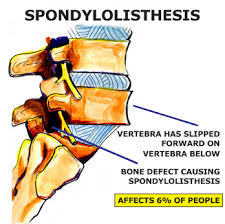Spondylolisthesis
A condition that affects the vertebral bodies of the spine most commonly in the lumbar spine. It describes one vertebral body moving forward in relation to another vertebral body below. It is often related to previous stress fractures that may have developed in early childhood which has now progressed to full fracture of the vertebrae.
What is this?
Is a condition that affects the vertebral bodies of the spine most commonly in the lumbar spine. It describes one vertebral body moving forward in relation to another vertebral body below. It is often related to previous stress fractures that may have developed in early childhood which has now progressed to full fracture of the vertebrae.
Causes
Some of the causes of spondylolisthesis include:
- Dysplastic – malformation of the lumbar-sacral junction
- Degenerative
- Traumatic
- Pathologic – auto-immune disease/infection
Grades
- Grade 1 – slipped up to but no greater than 25%
- Grade 2 – slipped between 25-50%
- Grade 3 – slipped between 50-75%
- Grade 4 – slipped greater than 75%
Pain and Symptoms
- Grade 1 there is usually minimal discomfort associated with this they may experience some intermittent lower back pain
- Grade 2+ there is usually localised lower back pain with or without referred peripheral symptoms into the lower limb
Diagnosis
Of this condition can be confirmed with lateral X-ray. MRI will more often be performed as it will give you a better all round picture of the pathology in the lumbar spine.
Treatment
Conservative management will usually only be successful in grade 1-2 and this would include:
- Activity Modification – A period of activity modification will be required to help unload the back and allow the area to settle.
- Bracing – A short period of bracing may assist in protecting the injured area and facilitate a quicker recovery
- Manual Therapy – Designed to help relieve the stiffness above and below the affected region.
- Pain Medication – Early on appropriate pain medication prescribed by your GP may be appropriate in helping to control symptoms.
- Exercises – A Physiotherapist designed and supervised exercise program is important to ensure restoration of full movement, strength and function.
Surgical
In very severe Grade 3 + spondylolisthesis with a failed conservative management plan a surgical review may be required to discuss appropriate future treatment options.
Recovery Time
- Grade 1-2 – 4-8 weeks
- Grade 3+ – 3 months plus dependent on surgery if required.

